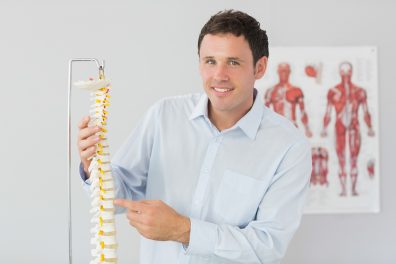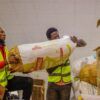Manual Handling Case Study
A large banking group, City of London


Shane Morris – Osteopaths For Industry trainer
I recently conducted a manual handling training session with a large bank in the City of London. It’s not just bankers that are required to keep such institutions running – during my training sessions I was working with porters, caretakers, chefs and table-service staff.
The first question I asked was “who thinks their job involves tasks that are high risk in terms of injury?” The porters’, chefs’ and caretakers’ hands shot up immediately but the service staff’s remained fixed to their side. Why didn’t they think their jobs were high risk? Because they weren’t lifting anything heavy!
This is something I encounter often. There is a strongly held, but false, belief that only heavy lifting will cause us injury. In reality, it is often lighter items that do the damage, especially if they’re handled repetitively. This happens because we are less vigilant of our technique with lighter loads and more likely to get into compromised postures.
We are less vigilant of our technique with lighter loads and more likely to get into compromised postures.
My first job with the bank staff, as with any training session, was to convince them of the importance of proper manual handling technique. As an osteopath I find this easy. When you see the tragedy of people who have worked hard all their lives, but are unable to enjoy the fruits of their labour in retirement because of a perfectly preventable injury, such as osteoarthritis of the spine, it gives you great conviction when extolling the virtues of lifting and handling correctly.
To shift the delegates out of their comfort zone I got them to perform a group risk assessment for a scenario completely alien to them – baggage handlers loading luggage onto a plane. In assessing an unfamiliar scenario, the delegates were forced to really think. By coming up with solutions to the baggage-handling scenario they were able to discover concepts they could apply to their own roles – concepts such as job rotation and the use of mechanical aids. A fundamental part of Osteopaths For Industry training is that we do not simply teach people a bunch of techniques. We insist on training delegates to be able to think on their feet, assess situations and apply some key principles. This is the only way to deliver training that is actually implementable in the workplace.
Training delegates to think on their feet is central to the Osteopaths For Industry philosophy.
 In virtually every training session I do, and the bank was no exception, delegates are particularly interested when discussing anatomy. We have an inherent interest in our own bodies. Looking at the different lifting techniques in relation to the body drove home why bad technique, such as stooping, is likely to cause injury.
In virtually every training session I do, and the bank was no exception, delegates are particularly interested when discussing anatomy. We have an inherent interest in our own bodies. Looking at the different lifting techniques in relation to the body drove home why bad technique, such as stooping, is likely to cause injury.
Having established the health benefits of good technique we moved onto the practical. We demonstrated and performed semi-squats, pushing & pulling and team lifts.
As with every session, some delegates took to the semi-squat quicker than others. The guy who lifts weights in the gym found it easy because the technique is virtually the same as the dead lift. Critically though, by the time we finished everyone was confident they could practice and implement the technique for themselves at home and at work.
A trolley used by the service staff was used to demonstrate pushing and pulling technique. We discovered many were over using the upper body when turning the trolley. A brief demonstration and plenty of practice using the feet to make the turn allowed the service staff to adapt their technique to make it more efficient and reduce strain on the upper body.
To discuss team lifting in context, we used furniture frequently handled by the caretakers that was causing some problems. We established that they were lifting well in many respects, communicating clearly and using generally good technique. By simply tweaking their position and getting them to move around the corner of the chairs, we were able to give them more control and reduce the risk of injury.
Spending time in the bank has had me thinking of investing. We are all familiar with the concept of investing some of our salary at the end of each month to provide us with a retirement we can enjoy. But have you thought about investing in your health? Not your money, but your time.
Taking the time to learn how to lift and handle properly, to use good posture and look after your body so you can do all the things you’ve got planned for your retirement is an investment you won’t regret.
Shane Morris is a manual handling trainer for Osteopaths For Industry.



